|
|
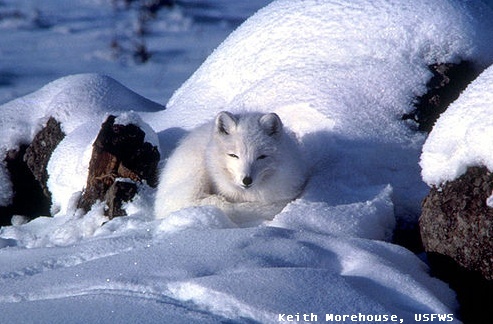
|
|

This fox is found in the far north, mainly in the Arctic Circle. (northern parts of Alaska and the Northwest Territories, Nunavut, on Iceland , northern Russia and on the coast of Greenland). map
The Arctic fox lives in a den or burrow dug into the side of a hill, cliff or riverbank. The den has more than one entrance. In winter it may tunnel into a snowbank.
The Arctic fox is well adapted to live in the cold Arctic. In winter its thick, bushy coat turns white. This makes it very hard to see the fox. The prey is not able to spot the Arctic fox until it is too late.
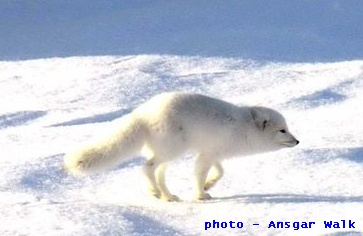
Because of its thick coat, it is able to survive in freezing cold temperatures. Thick hair on the pads of their feet protects their feet from freezing and helps them to walk on the ice. The Arctic fox can walk on ice without slipping. It uses ice floes to travel in search of food in the winter.It can curl up in the snow and cover its nose and face with its bushy tail to keep warm.
In the summer the fox will hide food in its den or under rocks. This is how it stores food for later use.
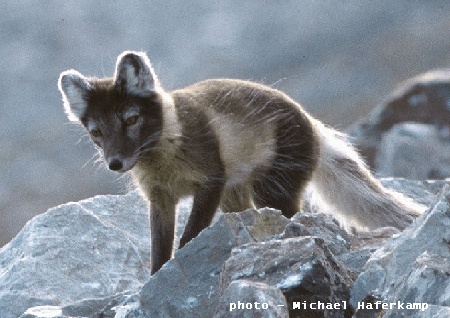
The Arctic fox is small (about the same size as a large cat) with short legs and short rounded furry ears. The bushy tail is about 30 cm. long. Its thick fur coat makes it look much larger than it really is. When the snow starts to melt, the fox sheds its winter coat for a thinner greyish-brown coat. Near the end of summer the Arctic fox begins to grow a thicker coat again. The color of the fur turns grey and then white. The oily fur sheds water and helps to keep the fox dry.
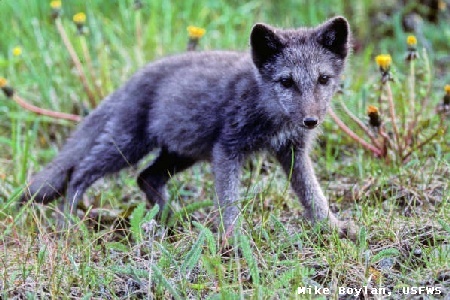
The average litter is 11 pups or "whelps". The babies are born in a den or burrow in late spring. A baby fox is the size of a kitten. Both parents take care of the blind pups. At two weeks they open their eyes. At three weeks they go outside and begin to explore.To feed a litter of ten the parents must kill about thirty lemmings a day. When their family is almost grown, the parents feed them over a hundred lemmings a day! The young foxes are taught how to hunt and are independent by fall.
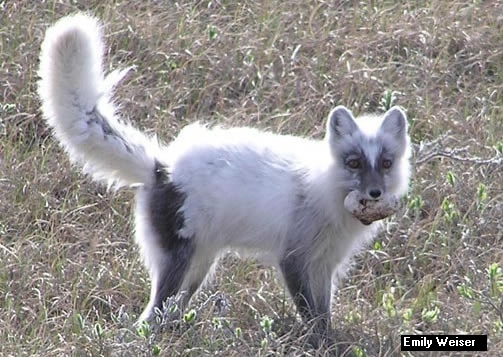
They prey on voles, lemmings, hares, ground squirrels, birds and birds' eggs. Foxes living near the coast feed on shellfish, sea urchins and other shore animals. They check the shoreline for dead seals, whales and dead fish . When meat is not available the Arctic fox eats fruit and berries.The Arctic fox will even kill baby seals if the fox can find the seal's den in the snow .
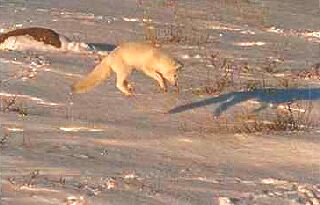
The Arctic fox walks along the top of the snow and listens for small animals running under the snow. When they hear something, they jump up and down to break through the snow with their front paws. Once they break through, they can grab their prey.
Polar bears kill Arctic foxes. Trappers want them for their beautiful fur coats.
The Arctic fox can run quickly and is well camouflaged in the winter and in the summer.
It does not hibernate during the winter.
Those living in the coldest Arctic areas follow polar bears and feed on the left-overs.
Some Arctic foxes have a steel blue winter coat.
J.Giannetta
credits: (images and information)
information - Hinterland Who's Who - The Arctic Fox
jgiannet@hotmail.com
2003
updated August 2011
arctic fox resting - Keith Morehouse, US Fish and Wildlife Service, license - Public Domain
arctic fox walking - Ansgar Walk, Wikipedia , license - Creative Commons Attribution ShareAlike 2.5
arctic fox in summer - Michael Haferkamp, Wikipedia , license - GNU Free Documentation License
arctic fox pup - Mike Boylan, US Fish and Wildlife Service, license - Public Domain
arctic fox with egg - Emily Weiser, Mammals of the North Slope (Alaska), used with permission
arctic fox pouncing - source unknown